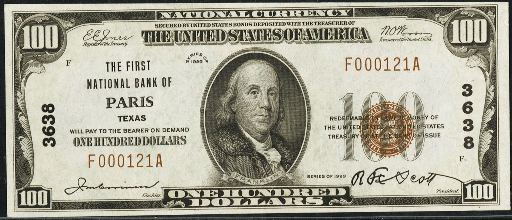The Citizens National Bank Of Winterset
The Citizens National Bank Of Winterset in Iowa printed $1,424,860 dollars worth of national currency. Over $1,000,000 face value is a lot of money. However, some types and denominations of currency from this bank could still be rare. This national bank opened in 1872 and stopped printing money in 1934, which equals a 63 year printing period. That is considering a long operation period for a national bank. During its life, The Citizens National Bank Of Winterset issued 14 different types and denominations of national currency. We have examples of the types listed below. Your bank note should look similar. Just the bank name will be different. For the record, The Citizens National Bank Of Winterset was located in Madison County. It was assigned charter number 2002.
We buy all national currency. Please call or email us for a quote. Sales@AntiqueMoney.com
The Citizens National Bank Of Winterset in Iowa printed 1,700 sheets of $1 original series national bank notes. A print range between 1,000 and 2,500 is small. Combine that with something that was printed before 1875 and you can imagine that these notes are few and far between. One of the most interesting things about early first charter one dollar national bank notes is all of the different slight variations you can find. Some notes have a red charter number, others do not. Some have red serial numbers and some have blue serial numbers. Some are printed on white paper and others are printed on paper with a slight blue tint. You can really find lots of different ways to collect these. Generally speaking, prices for “first charter aces” are down from their highs. So there are some bargains in this arena of collecting.
Original Series $1 National Bank Note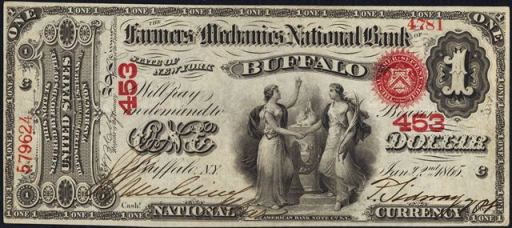
The Citizens National Bank Of Winterset printed 1,700 sheets of $2 original series national bank notes. It is important to know production numbers for original series two dollar bills for informational purposes. All $2 bills printed before 1875 are very rare and highly desirable. Most survivors represent the only known example for that bank. Collectors call these $2 bills lazy deuces. The large two on the face of the bill is pictured horizontally, thus making it look lazy. Don’t be fooled by the silly name though. These can be worth significant amounts of money on many occasions.
Original Series $2 National Bank Note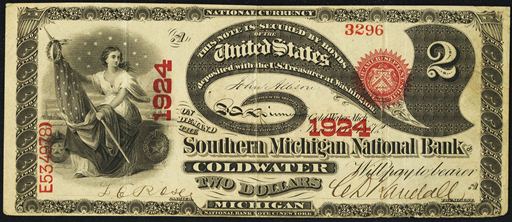
The Citizens National Bank Of Winterset also printed 2,375 sheets of $5 original series national bank notes. A print range between 1,000 and 2,500 is small. Combine that with something that was printed before 1875 and you can imagine that these notes are few and far between. Each five dollar original series bank note has a spiked red seal. That is pretty much the only design difference between it and later issues. These are really beautiful notes. One neat thing about these is that the back of each note has a vignette of the corresponding state seal. Some of the state seals are very imaginative. Collecting by state seal was very popular early on in the hobby. Today most collectors are more concerned about bank of issue and condition. Serial number one bank notes are also extremely popular.
Original Series $5 National Bank Note
The Citizens National Bank Of Winterset also printed 5,908 sheets of $5 series of 1875 national bank notes. A print range between 5,000 and 10,000 is a pretty high number. But you have to remember we are talking about bank notes from the 1870s and 1880s. Even banks with high issue numbers could be rare today. Series of 1875 $5 bills are some of the most commonly encountered bank notes from the first charter series. Only the original series $1 bill is more available. Some banks exclusively issued five dollar bills. So if you want an example from one of those banks then you don’t have many options. These notes have a rounded red seal and red serial numbers. They also all have a red charter number.
Series of 1875 $5 National Bank Note
The Citizens National Bank Of Winterset also printed 390 sheets of $50 1882 brown back national bank notes. Fifty dollar 1882 brown backs are few and far between. When the print number is under 1,000 like this bank then there is a great chance that you have a very rare bank note. The most common 1882 $50 brown backs are worth about $5,000. However, some can be worth more than $10,000 based on condition, serial number, and bank of issue.
Series of 1882 $50 Brown Back
The Citizens National Bank Of Winterset also printed 390 sheets of $100 1882 brown back national bank notes. High denomination $50 and $100 brown backs were printed on the same sheet. So the number of sheets printed also equals the number bills printed for each denomination. You can see that $100 brown backs are extremely scarce on this bank. We are very interested in purchasing $100 1882 brown back national bank notes. We have paid more than $15,000 for some examples. Send us pictures of what you have and we will respond quickly with an appraisal and offer.
Series of 1882 $100 Brown Back
The Citizens National Bank Of Winterset also printed 54 sheets of $50 1882 blue seal national bank notes. High denomination 1882 blue seals like this are not frequently encountered, regardless of the number of notes printed. There is a big difference between the two types of 1882 $50 blue seals. The variety that says “1882-1908” on the back is rare, but no where near as rare at the type that says “Fifty Dollars.” The second variety is extremely rare and only about a half dozen are known to exist. The first type should still be worth at least $4,000. The second type is a five figure rarity though.
1882 Blue Seal $50 National Bank Note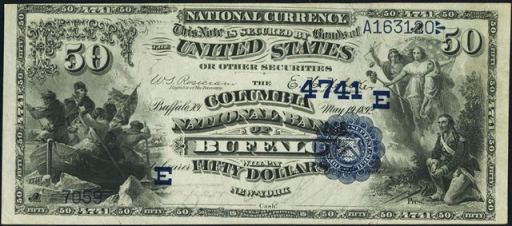
The Citizens National Bank Of Winterset also printed 54 sheets of $100 1882 blue seal national bank notes. The number of sheets printed doesn’t matter too much here. All 1882 $100 blue seals are rare. They were issued by a total of 256 total national banks in the country. The rare 1882 value backs were only printed by banks in Dayton, Ohio and New Orleans, Louisiana. The slightly more common date backs are much more plentiful but still rare in the scheme of things.
1882 Blue Seal $100 National Bank Note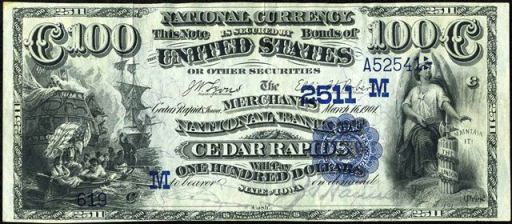
The Citizens National Bank Of Winterset also printed 3,672 sheets of $50 1902 blue seal national bank notes. There is no trick to knowing which 1902 blue seals will be common and rare. Often times the number printed won’t tell you much information. The value still comes down to condition and demand. That is a surprise to most people. In fact, most 1902 $50 bills we see are worth between $750 and $1,250. The rarer ones can be worth more than $5,000. However, there isn’t much middle ground.
1902 $50 Blue Seal National Bank Note
The Citizens National Bank Of Winterset also printed 3,672 sheets of $100 1902 blue seal national bank notes. It is no coincidence that the sheet numbers for $50 bills and $100 bills are the same. They were printed on the same sheets. Most $100 blue seals are at least scarce; others can be very rare. John J Knox is printed on the front of each bill. Most collectors like the back design a lot more though. It is really unique and different from most other national bank notes. Prices for 1902 $100 blue seals are pretty similar to $50 blue seals. They are both equally common or equally rare, depending on how you look at it.
1902 $100 Blue Seal National Bank Note
The Citizens National Bank Of Winterset also printed 721 sheets of Type1 1929 $10 national bank notes. This is a small print range, but it does not guarantee rarity. Each $10 bill from 1929 has a portrait of Alexander Hamilton on it. The black number written vertically is the charter number. The charter number never affects the value; it is just an identifier. The ten dollar type1 national bank note happens to be the single most common national bank note, with over 65,000 known to exist from all banks. Of course each note is valued based on its condition and rarity. Some are very rare.
Series of 1929 Type1 $10 National Bank Note
The Citizens National Bank Of Winterset also printed 297 sheets of Type1 1929 $20 national bank notes. That may sound like a very small number, and it is. However, when it comes to small size notes, that print range usually allows for a handful of survivors. Andrew Jackson is featured on the front of each 1929 $20 bill. Be sure to take note of the serial number on your specific bank note. If it is 000001 then you can expect a nice premium. There is a special market for serial number one bank notes. Of course, even if the number isn’t #1, it could still be collectible and have a high value just based on its condition and rarity alone.
Series of 1929 Type1 $20 National Bank Note
The Citizens National Bank Of Winterset also printed 376 sheets of Type1 1929 $50 national bank notes. That may sound like a very small number, and it is. However, when it comes to small size notes, that print range usually allows for a handful of survivors. As is the case with all modern fifty dollar bills, Ulysses Grant is pictured on the front of 1929 $50 bills. This is a higher denomination that was only printed by 300 different national banks. Many examples are only worth around a few hundred dollars. Rarer specimens can sell for more than $1,000.
Series of 1929 Type1 $50 National Bank Note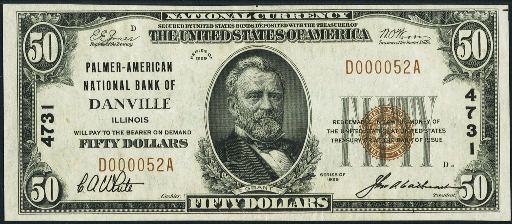
The Citizens National Bank Of Winterset also printed 124 sheets of Type1 1929 $100 national bank notes. That is an extremely small sheet printing number. Survivors are still likely but definitely not guaranteed. Despite saying series of 1929, all type1 national bank notes were actually printed between 1929 and 1933. Exactly 289 national banks printed $100 type1 notes. Most are relatively common. However, as with anything, there are always exceptions to that rule.
Series of 1929 Type1 $100 National Bank Note